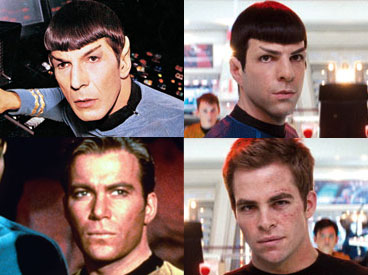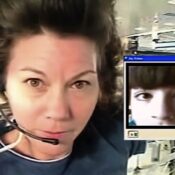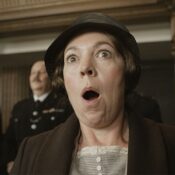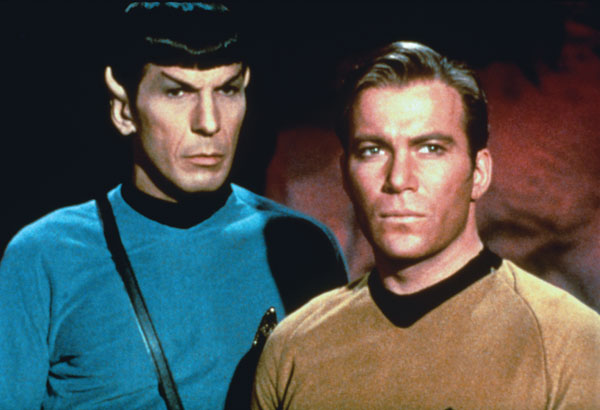
Captain Kirk in Star Trek. Courtesy NBC/Photofest.
Director J. J. Abrams, whose Star Trek Into Darkness opened May 2013, is not counting on the sci-fi special effects (although there will be plenty) to guarantee the success of the sequel to his huge 2009 hit Star Trek. “I want it to be real and relevant,” he says, speaking of the 12th film based on the iconic ’60s TV show. “Cool as they are, the spaceships and the gadgetry aren’t what really matters.”
For Abrams, the crew of the Enterprise is paramount. “You want to be cruising with them on an amazing and fun adventure,” he says, echoing the words of Star Trek’s late creator, Gene Roddenberry, who famously pooh-poohed the technology component of his stories: “I wrote my daydreams,” he said. And his late wife Majel Barrett-Roddenberry pointed out: “He wrote about things that he understood, and that wasn’t science, it wasn’t technology.”
Maybe Roddenberry put his other interests before science, but there are countless concepts and tools we first encountered on Star Trek that have since become, not only real, but a part of our lives.
“Their Universal Translator? Today we’ve got an app for that,” notes Linda Wetzel, who teaches a course at Georgetown University on the philosophy of Star Trek. “We may not have phasers, but we have lasers and tasers. And we can talk to computers now, and they understand us.”
But the show was never really about the gear: “The original series tackled burning issues of the day,” says Wetzel. “It explored big ideas—philosophical, political, and scientific. Star Trek asks ‘What if?’ and just runs with it.”
The show first beamed into millions of living rooms in the tumultuous ’60s when visions of Armageddon danced in our heads; the U.S. and the Soviet Union were uneasy adversaries in a nuclear stand-off. Space exploration had become a priority after the Russians one-upped us with the launch of the Sputnik satellite followed by Uri Gagarin’s historic flight into space. We responded with a huge and expensive effort to put a man on the moon.
Against this dark, historical backdrop, Star Trek broke new ground with a racially diverse spaceship crew that included Nichelle Nichols as communications officer Uhura and George Takei as helmsman Sulu. It held out the possibility that an uncertain future could have a happy ending as The Federation tried to contain the vicious and violent Klingons, whose homeworld Kronos was a superpower not unlike the Soviet Union, while the Enterprise discovered life on other planets. And the series explored timeless questions about where we were going—not just in outer space but in our lives as human beings.
As William Shatner, the original Captain Kirk, explains, “A wonderful story is something people can relate to—whether it’s a search inside or an exploration of our future in space. I think the real, lasting connection is that we entertain people. I never came to the set thinking ‘Today I save the universe.’ I usually would say, ‘Where are the bagels?’”
Professor George Slusser, curator of the Eaton Collection of Science Fiction and Fantasy at University of California, Riverside, agrees. It’s important, he notes, that Roddenberry never let the values he promoted stand in the way of entertaining his audience. “A person who has a hard day isn’t interested in reading about philosophy or hard science,” Slusser says. “But they will sit down with a beer in their hand and watch Star Trek and encounter some grand ideas. And they may not even realize they’re getting them.”
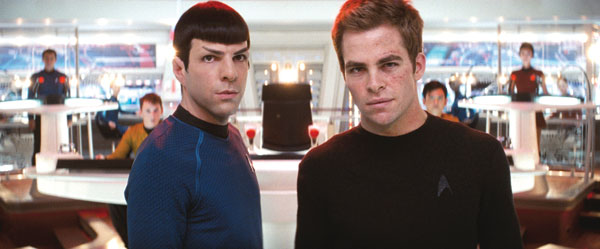
Captain Kirk in Star Trek. Courtesy Paramount/PhotoFest.
As the late James Doohan who played Scotty once put it, “We knew about the lessons in Star Trek, and we knew as actors how important it was that we get them across. I remember Roddenberry once said to me, ‘If we think it’s going to be difficult for the audience to believe something, we’ll just cut to your close-up.’ I thought that was marvelous.”
Leonard Nimoy, who became legendary as Mr. Spock, says that Roddenberry’s perspective on life changed his own. “I was much more emotional before I started to play him,” he remembers. “Spock had a big impact on me personally. It made me understand better how to approach a difficult situation without the emotion taking over. And I hope some of that was passed on to the audience.”
What could have been the end of Star Trek turned out to be a new beginning. After three seasons on NBC, the series was cancelled because of low ratings. But in a serendipitous twist, reruns in TV syndication became more popular than the series had been on NBC and also attracted a coveted younger audience. That led to the first Enterprise venture on the big screen, Star Trek: The Motion Picture. The flick got mixed reviews for drawing mainly on previously produced television episodes, but it scored huge at the box office with ticket sales of $82.3 million domestically, thanks in large part to Trekkers who returned to see it countless times.
The movie’s success jump-started a string of sequels, which were basically review-proof as Trekkers rallied around the box office—although many claimed, in a strange calculation with which a lot of critics seemed to agree, that the even-numbered sequels were always better than the odd-numbered ones.
Roddenberry had little involvement in Star Trek on the big screen but, nearly 20 years after the TV series had debuted on prime time, he re-imagined his vision in the syndicated Star Trek: The Next Generation, or TNG for short. An entirely new cast was led by Patrick Stewart as Captain Jean-Luc Picard, who had the emotional control that was often missing in the impulsive Kirk, and the series’ trademark diversity included Whoopi Goldberg as an alien bartender and LeVar Burton as the blind engineer.
The series reflected a new time in America. While Captain Kirk’s Enterprise was always pressing on to a new planet and another conflict, Captain Picard headed a calmer and more sophisticated ship, complete with chamber music concerts. There was not much fighting but a lot of negotiating. The Klingons had been tamed and were now allies of The Federation. Everything was running pretty smoothly except for frequent technical turmoil ranging from dangerous radiation leaks to warp jumps that had to be calculated to the nanosecond.
Become a Saturday Evening Post member and enjoy unlimited access. Subscribe now
